by Margherita Guarducci
© 1960, Hawthorn Books
(all rights reserved)
| Grottoes
Vatican City Colonnade Saints Floorplan #2 |
|
|
|
|
CONTENTS
Introduction
- H. V. Morton
Preface - The Author
Illustrations
I. THE TESTIMONY OF ANCIENT AUTHORS
II. THE VATICAN IN ANCIENT TIMES
III. THE NECROPOLIS UNDER
THE BASILICA
IV. THE APOSTLES MEMORIAL
V. THE TESTIMONY OF THE
INSCRIPTIONS
VI. THE CULT OF THE APOSTLES PETER
AND PAUL ON THE APPIAN WAY
VII. CONCLUSIONS
The Author and Her Book
V.
THE TESTIMONY OF THE INSCRIPTIONS
(Page 2)
And now it is time to examine directly some of the graffiti on Wall G. I must limit myself here to a necessarily small selection, which however, I hope, will be sufficient to give an idea of this document and of its historic and religious importance. Passing over many graffiti which are nevertheless noteworthy from many points of view, I think it would be appropriate to call attention to some of those that speak of the Apostle and to those, of great historic interest, which allude to Constantine and his victory.
On the upper part of Wall G, toward the left, there is a graffito written in large and prominent letters: LEONIA (PLATES IV, V.)
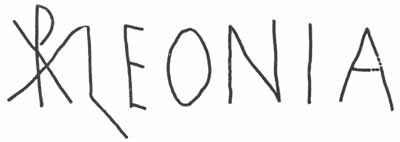
It is the name of a dead woman, preceded by the monogram of Christ. But this is only what we might call the basic graffito. With appropriate additions it became a true embroidery of thoughts expressing the faith of the survivors and their hope that this soul might enjoy the prize of eternal blessedness. Let us observe some of the details of this pious embroidery.
The
![]() which
precedes the name of the deceased was enriched with new values. At its
upper extremity a line was drawn to unite the symbol of Christ (
which
precedes the name of the deceased was enriched with new values. At its
upper extremity a line was drawn to unite the symbol of Christ ( ![]() ) with that of the Cross (T) (Plates IV, IX).
) with that of the Cross (T) (Plates IV, IX).
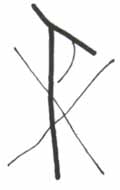
This line then serves as the basis of an E which lies almost flat on top of the P in the . (Plates IV, IX.)
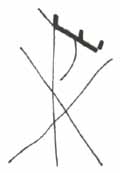
Some
ancient Roman Christian inscriptions show that the P in ![]() could have the Latin meaning of pi besides its original Greek meaning
of rho. For example, seals found in the catacomb of St. Agnes bear
a
could have the Latin meaning of pi besides its original Greek meaning
of rho. For example, seals found in the catacomb of St. Agnes bear
a ![]() whose
P functions simultaneously as rho and pi. Note that this
is the case with the Latin pi in the word SPES from the phrase
Spes Dei (Fig. 37).
whose
P functions simultaneously as rho and pi. Note that this
is the case with the Latin pi in the word SPES from the phrase
Spes Dei (Fig. 37).
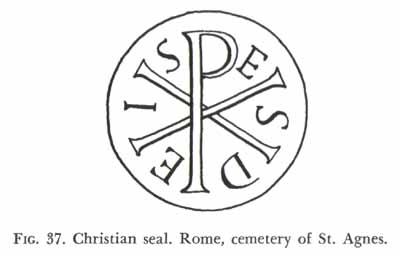
In the
![]() of
our wall inscription we can also find the double value of rho and
pi and recognize the union of Christ's sign with that of Peter
(PE). (Plates IV, IX.)
of
our wall inscription we can also find the double value of rho and
pi and recognize the union of Christ's sign with that of Peter
(PE). (Plates IV, IX.)
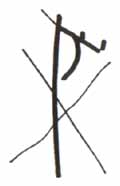
In addition,
by using the vertical line of the ![]() and the line added above, and carving three more lines, a group of three
A's was produced, one inside the other. As I have said, this is a symbol
of the Holy Trinity, AAA (Plates IV, IX).
and the line added above, and carving three more lines, a group of three
A's was produced, one inside the other. As I have said, this is a symbol
of the Holy Trinity, AAA (Plates IV, IX).
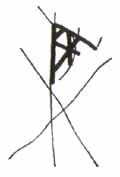
Finally,
the addition of a small line at the upper end of one of the diagonal strokes
of the ![]() made it possible to form an N with the right stroke very prolonged (a
sign which corresponds to the syllable NI in Latin palaeography). A C
was added at the left of the upper vertical line in the
made it possible to form an N with the right stroke very prolonged (a
sign which corresponds to the syllable NI in Latin palaeography). A C
was added at the left of the upper vertical line in the ![]() ,
and thus the word NICA (Greek nika) was formed to serve as a cry
of victory. (Plates IV, IX.)
,
and thus the word NICA (Greek nika) was formed to serve as a cry
of victory. (Plates IV, IX.)
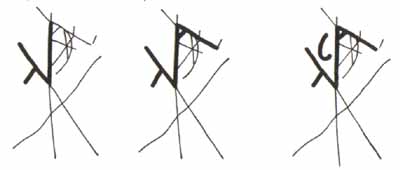
This ingenious embroidery therefore became a cry of victory directed at Christ and Peter, mingled with thoughts of the Cross of salvation and the Holy Trinity.
Next,
the inscription I VIVIS TV is written across the precious ![]() (Plates IV, IX)
(Plates IV, IX)
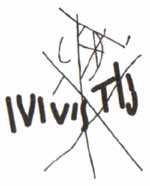
and enriched by the addition W APRT (Plates IV, IX)
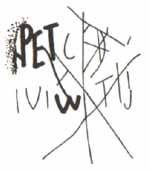
which forms the phrase i(n) vivis tu v(i)v(e) a(d) Pet(rum): the wish that the deceased may be among those "living" souls which enjoy the life of the next world close to Peter ("may you live among the living close to Peter").
The same wish I VIVIS AP II (Plate IV)

with the E expressed, this time, in the cursive form by two parallel lines ( II ), can be seen, written apparently by the same hand, a bit lower.
The letters of the name LEONIA were next elaborated in a remarkable way to express religious concepts and good wishes. For example, the L was transfigured into a sign of Peter (Plate IV)
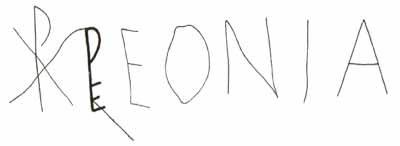
for the purpose of inscribing the helpful sign of the Apostle in the name of the deceased. The final A was transformed into a small treasure chest of precious thoughts. First, on the right stroke, two more A's were erected to present the trinitarian concept AAA (Plates V, X)
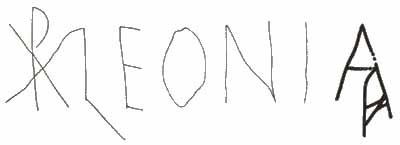
and to the left of the letter, above it, was written the preposition IN, with the evident purpose of expressing the wish for life in the threefold God: IN AAA (Plates V, X)
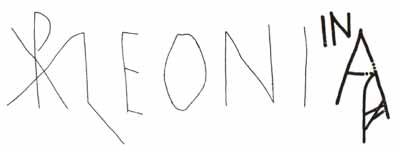
In addition,
the second of the three A's was enriched with the symbol of Christ ![]() (Plates V, X)
(Plates V, X)
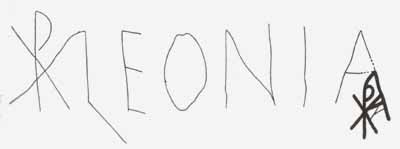
very
appropriately, since Christ is the second Person of the Holy Trinity.
The ![]() , in turn, was
then enriched with three more small A's (Plate V, X)
, in turn, was
then enriched with three more small A's (Plate V, X)
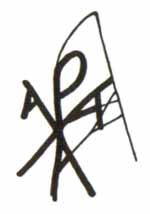
Finally,
on either side of the ![]() were written the letters A and P (Plates V, X)
were written the letters A and P (Plates V, X)
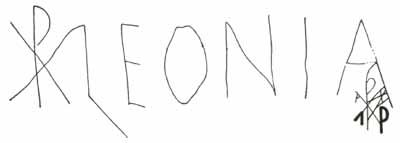
signifying the wish for life close to Peter (a(d) P(etrum)).
Now let us consider a graffito located near the center of the wall. The inscription consists in the names of four dead persons written on two lines and then repeated all together on a third line: VENEROSA VEA / VERV BONIFATIA / VERVS BONIFATIA VENEROSA VEA (Plates V, VI, VII).
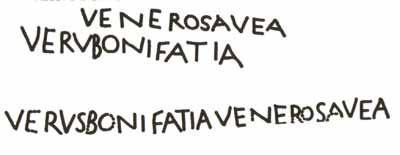
Here, too, the names of the deceased were elaborated with ingenious embroidery to express many thoughts and wishes. Let us examine a few of them.
Beginning
at the bottom and moving upward, we notice a ![]() set up directly above the second A of Bonifatia on the third line;
a
set up directly above the second A of Bonifatia on the third line;
a ![]() written
in such a way that it was located between three A's (besides the A on
which it stands, the two A's of Bonifatia on the second line).
(Plates VI, VII, XI.)
written
in such a way that it was located between three A's (besides the A on
which it stands, the two A's of Bonifatia on the second line).
(Plates VI, VII, XI.)
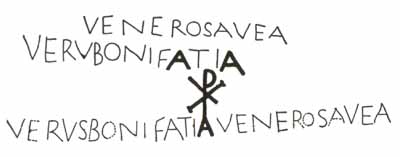
A sign of union binds this to the T of Bonifatia on the second line, undoubtedly to express the idea that Christ is closely associated with the Cross (T) (Plates VI, VII, XI)
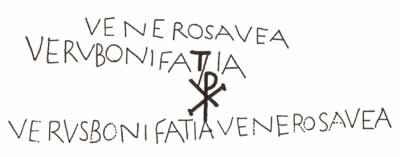
As in
the Leonia graffito, the ![]() here is also flanked by A and P, signifying the wish for life close to
Peter.
here is also flanked by A and P, signifying the wish for life close to
Peter.
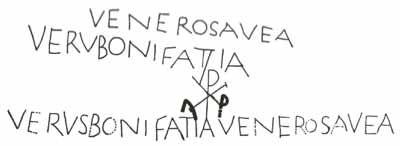
Another link binds together the first A of Bonifatia on the second line and the O of Venerosa on the first line, obviously to produce the formula AO signifying God (or Christ) beginning and end of the universe. (Plates VI, VII, XI.)
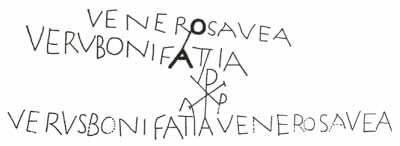
There
is also a second ![]() linked with a A (Plates VI, VII, XI.)
linked with a A (Plates VI, VII, XI.)
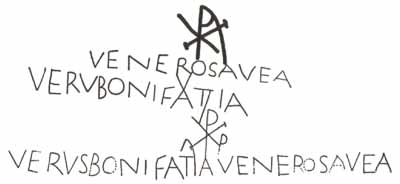
written above the O and A of Venerosa on the first line, (Plates VI, VII, XI.)
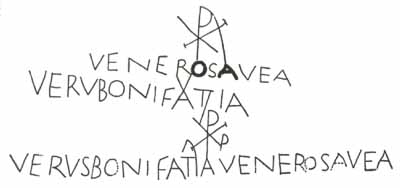
This
expresses the concept that through "Christ-life" ( ![]() A) one can pass from death to life ( O A ).
A) one can pass from death to life ( O A ).
But
the writer of the grafito was not yet satisfied. Adding an E to the base
of the ![]() and using the P as both rho and pi, he managed to produce
the customary union of Christ's name (
and using the P as both rho and pi, he managed to produce
the customary union of Christ's name ( ![]() ) with that of Peter (PE). (Plates VI, VII, XI.)
) with that of Peter (PE). (Plates VI, VII, XI.)
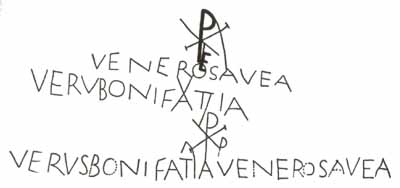
At the
top of the ![]() was written (perhaps by another hand) the cry of victory NICA (the Greek
nika) (Plates VI, VII, XI.)
was written (perhaps by another hand) the cry of victory NICA (the Greek
nika) (Plates VI, VII, XI.)
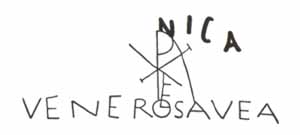
and, writing an M ove the and taking advantage of the A in nica, the entire name of Mary was carved (Plates VI, VII, XI.)
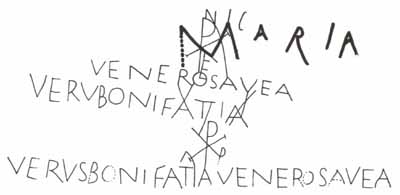
Christ, Peter and Mary are thererfore linked together, as they are also in other parts of Wall G, in the same cry of victory.